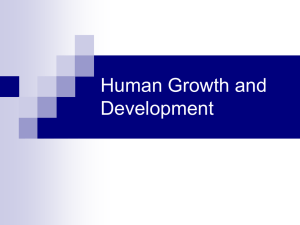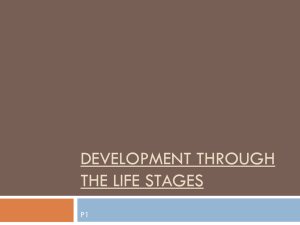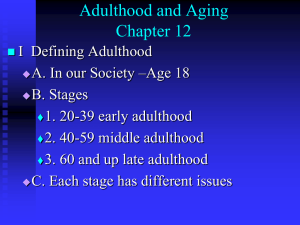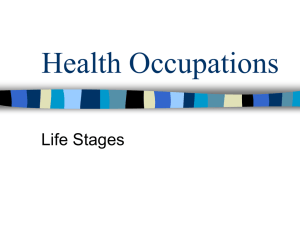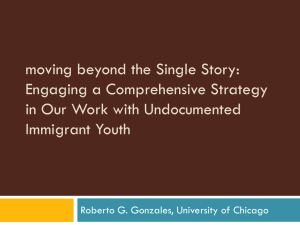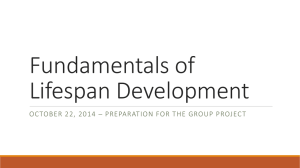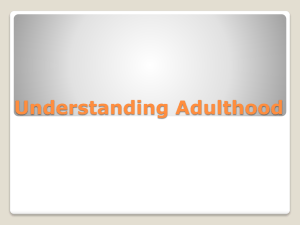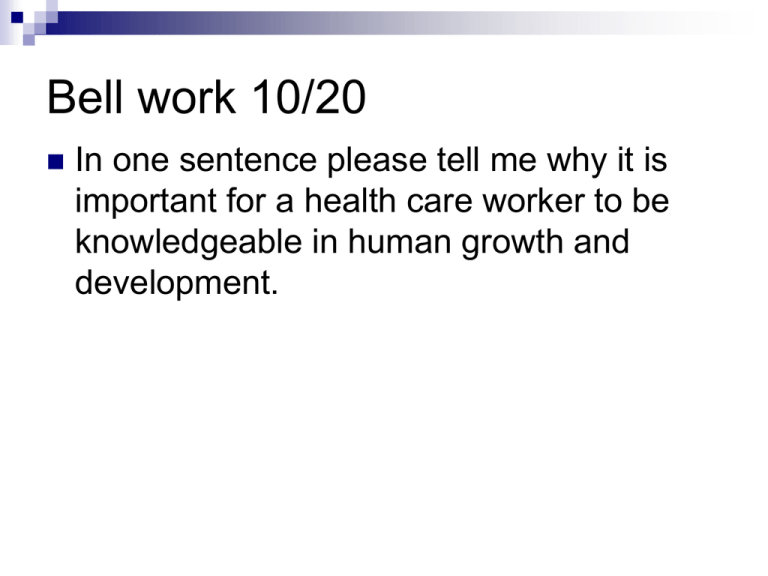
Bell work 10/20
In one sentence please tell me why it is
important for a health care worker to be
knowledgeable in human growth and
development.
Unit 7 Human Growth
and Development
7:1 Life Stages
Growth and development begins at birth
and ends at death
During an entire lifetime, individuals have
needs that must be met
Health care workers need to be aware of
the various stages and needs of the
individual to provide quality health care
Life Stages
Infancy: birth to 1 year
Early childhood: 1-6 years
Late childhood: 6-12 years
Adolescence: 12-20 years
Early adulthood: 20-40 years
Middle adulthood: 40-65 years
Late adulthood: 65 years and up
Four main types of Growth and
Development
Physical: body growth
Mental: mind development
Emotional: feelings
Social: interactions and relationships
with others
All four types above occur in each stage
Erikson’s Stages of
Psychosocial Development
Erik Erikson was a psychoanalyst who
identified eight stages of psychosocial
development
For each stage a basic conflict or need
must be met
See Table 7-1 in text
Infancy
Age: birth to 1 year old
Conflict – Trust vs. Mistrust
Dramatic and rapid changes
Physical development– roll over, crawl, walk,
grasp objects
Mental development—respond to cold, hunger,
and pain by crying. Begin to recognize
surroundings and become aware of
surroundings and people
Infancy
Emotional development – show anger,
distrust, happiness, excitement, etc.
Social development – self-centeredness
concept of the newborn to recognition of
others in their environment
Infants
are dependent on others for all needs
Bell Work 10/21
What are the four types of growth and
development we will discuss for each life
stage?
Turn to page 191 in your book
PS – Happy Friday
Early Childhood
Age: 1-6 years old
Conflict:
Toddler 1 to 3 years - Autonomy vs. shame and doubt
Preschool 3 to 6 years – Initiative vs. guilt
Physical development – growth slower than in infancy.
Muscle coordination allows the child to run, climb, move
freely. Can write, draw, use a fork and knife
Mental development – verbal growth progresses, short
attention span, at end of stage ask questions, recognize
letters, and some words
Early Childhood
Emotional development – develop selfawareness and recognize the effect they have
on other people and things. Children feel
impatience and frustration as they try to do
things beyond their abilities. This lead to temper
tantrums (the terrible two’s)
Social development – at beginning of stage
very self-centered one year old to sociable six
year old. Strong attachment to parents. Needs
are food, shelter, protection, love and security.
Late Childhood
Age: 6-12 years old
Conflict – Industry vs. inferiority
Physical development– slow but steady. Muscle
coordination is well developed and children can engage
in physical activity that require complex motor-sensory
coordination
Mental development – developing quickly and much of
the child’s life centers around school. Reading and
writing skills are learned, understand abstract concepts
like honesty, loyalty, values and morals
Late Childhood
Emotional development -- the child achieves greater
independence and a more distinct personality. Fears are
replaced by the ability to cope.
Social development – changes from activities by
themselves to more group oriented. They are more
ready to accept the opinions of others and learn to
conform to rules, and standards of behavior. Needs are
the same as infancy and early childhood along with the
need for reassurance, parental approval, and peer
acceptance.
Bell Work 10/26
Why is important for a health care provider
to understand the needs of persons in
each life stage?
Adolescence
Age: 12-20 years old
Conflict – Identity vs. Role Confusion
Physical development – growth spurts, muscle
coordination slows. Development of sexual
organs and secondary sexual characteristics
(puberty). Secretion of sex hormones leads to
the onset of menstruation in girls and the
production of sperm and semen in boys. Body
shape and form changes.
Adolescence
Mental development – most foundations have
been set. Development primarily involves an
increase in knowledge and sharpening of skills.
Learn to make decisions and accept
responsibility for actions.
Emotional development – emotional
development is often stormy and in conflict.
Adolescents try to establish their identities and
independence. They respond more and more
to peer group influences.
Adolescence
Social development – spending less time with family
and more time with peer groups. They attempt to
develop self-identity and independence and seek
security from their peers. Toward the end of this stage
they develop a more mature attitude and develop
patterns of behavior that they associate with adult
behavior.
Need for reassurance, support and understanding. Problems
that develop in this stage can be traced to conflict and feelings of
inadequacy and insecurity.
Eating Disorders
Often develop from an excessive concern
for appearance
Anorexia nervosa
Bulimia
More common in females
Usually, psychological or psychiatric help
is needed to treat these conditions
Substance Abuse
Use of alcohol or drugs with the
development of a physical and/or mental
dependence on the chemical
Can occur at any life stage, but frequently
begins in adolescence
Can lead to physical and mental disorders
and diseases
Treatment towards total rehabilitation
Reasons Chemicals Used
Trying to relieve stress or anxiety
Peer pressure
Escape from emotional or psychological
problems
Experimentation
Seeking “instant gratification”
Hereditary traits or cultural influences
Suicide
One of the leading causes of death
in adolescents
Permanent
solution to temporary problem
Impulsive nature of adolescents
Most give warning signs
Call for attention
Reasons for Suicide
Depression
Grief over a loss or love affair
Failure in school
Inability to meet expectations
Influence of suicidal friends or parents
Lack of self-esteem
Increased Risk of Suicide
Family history of suicide
A major loss or disappointment
Previous suicide attempts
Recent suicide of friends, family, or role
models (heroes or idols)
Bell Work 10/26
What are two problems that can develop
during adolescence that are due to
feelings of inadequacy and insecurity?
Eating
disorders
Chemical abuse
Suicidal ideation
Early Adulthood
Age: 20-40 years old
Conflict Intimacy vs. Isolation
Physical development – basically complete.
Muscles are developed, strong and motor
coordination is at its peak.
Mental development – young adults seek
additional education, choose careers and
independence.
Early Adulthood
Emotional development – Young adults
are subjected to many emotional stresses
related to career, marriage, family, etc.
Social development – moving away from
peer group, and adults tend to associate
with others who have similar ambitions.
Most find a mate and begin a family.
Middle Adulthood
Age: 40-65 years of age
Conflict – Generosity vs. Stagnation
Physical development – Hair grey’s and thins,
skin wrinkles, muscle tone decreases, hearing
loss, visual acuity losses, weight gain.
Mental development – can continue to
increase. Confident decision makers and
excellent at analyzing situations.
Middle Adulthood
Emotional development – can be a
period of contentment and satisfaction.
Social development -- Family
relationships can decline as children begin
lives of their own and parents die. Divorce
rates are high. Friendships are with
people with similar interests and lifestyles.
Late Adulthood
Age: 65 years of age and up
Conflict – Ego integrity vs. despair
Physical development – on the decline.
Skin becomes dry and wrinkles, “age
spots” appear. Hair thins, muscles lose
tone and strength. Memory loss can occur
and reasoning ability can diminish.
Late Adulthood
Mental development – varies. People who
remain mentally active and are willing to learn
new things tend to show fewer signs of
decreased mental ability
Emotional development – Emotional stability
also varies.
Social development – retirement can lead to
loss of self esteem, lost identity. Death of
spouse and friends cause changes in social
relationships.
Bell Work 11/1 and 11/2
Why is being willing to learn important in
late adulthood?
Show
fewer signs of decreased mental ability
Which life stage is frequently the most
productive life stage?
adulthood – marriage, childbearing,
family, career,
Early
7:2 Death and Dying
Death is “the final stage of growth”
Experienced by everyone and
no one escapes
Young people tend to ignore its existence
Usually it is the elderly, who have lost
others, who begin to think about their
own death
7:2 Death and Dying
Death is “the final stage of growth”
Experienced by everyone and
no one escapes
Young people tend to ignore its existence
Usually it is the elderly, who have lost
others, who begin to think about their
own death
Research
Dr. Elizabeth Kübler-Ross was the leading
expert in the field of death and dying
Results of her research
Most
medical personnel now believe patient
should be informed of approaching death
Patient should be left with some hope and
know they will not be left alone
Staff need to know extent of information
known by patient
Research
(continued)
Dr. Kübler-Ross identified 5 stages of
grieving
Dying
patients and their families/friends may
experience these stages
Stages may not occur in order
Some patients may not progress through
them all, others may experience several
stages at once
Stages of Death and Dying
Denial – refuses to believe
Anger – when no longer able to deny
Bargaining – accepts death, but wants
more time
Depression – realizes death will
come soon
Acceptance – understands and accepts
the fact they are going to die
Caring for the Dying Patient
Very challenging, but rewarding work
Supportive care
Health care worker must have
self-awareness
Common to want to avoid feelings by
avoiding dying patient
Hospice Care
Palliative care only
Often in patient’s home
Philosophy: allow patient to die with dignity
and comfort
Personal care
Volunteers
After death contact and services
Right to Die
Health care workers must understand
this issue
Ethical issues must be addressed
Allowing patients to die can cause conflict
Specific actions to end life cannot be taken
Laws allowing “right to die”
Summary
Death is a part of life
Health care workers will deal with death
and dying patients
Must understand death and dying process
and think about needs of dying patients
Then health care workers will be able
to provide the special care these
individuals need
Bell work Nov 2, 3
What stage in the process of death and
dying does the person understand and
accept the fact they are going to die?
Acceptance
What stage in the process of death and
dying does the dying person try to make
deals with a higher power?
Bargaining
7:3 Human Needs
Needs: lack of
something that is
required or desired
Needs exist from birth
to death
Needs influence our
behavior
Needs have a priority
status
Maslow’s hierarchy of
needs
Maslow’s hierarchy of needs
Meeting Needs
Motivation to act when needs felt
Sense of satisfaction when needs met
Sense of frustration when needs not met
Several needs can be felt at the same time
Different needs can have different levels
of intensity
Methods for Satisfying
Needs
Direct methods – meeting a need and
obtaining satisfaction.
Hard
work
Set realistic goals
Evaluate situation
Cooperate with others
Methods for Satisfying Needs
Indirect methods of satisfying a need usually
reduce the need and help relieve tension if need
is unmet. The need is still there but its intensity
decreases.
Rationalization
Projection
Displacement
Compensation
Daydreaming
Repression
Suppression
Denial
Withdrawal
Bell Work 11/4
What is the difference between direct and
indirect methods of satisfying human
needs?
Defense Mechanisms
Rationalization
is putting something into a different
light or offering a different explanation for one’s
perceptions or behaviors in the face of a changing
reality.
a woman who starts dating a man she really, really likes and
thinks the world of is suddenly dumped by the man for no
reason. She reframes the situation in her mind with, “I
suspected he was a loser all along.”
is the placing a person’s undesired
thoughts, feelings or impulses onto another person
who does not have those thoughts, feelings or
impulses.
Projection
a spouse may be angry at their significant other for not
listening, when in fact it is the angry spouse who does not
listen.
Defense Mechanisms
Displacement
is the redirecting of thoughts feelings
and impulses directed at one person or object, but
taken out upon another person or object. People often
use displacement when they cannot express their
feelings in a safe manner to the person they are
directed at.
The classic example is the man who gets angry at his boss,
but can’t express his anger to his boss for fear of being fired.
He instead comes home and kicks the dog or starts an
argument with his wife. The man is redirecting his anger from
his boss to his dog or wife.
Defense Mechanisms
Compensation
is a process of psychologically
counterbalancing perceived weaknesses by
emphasizing strength in other arenas. By
emphasizing and focusing on one’s strengths, a
person is recognizing they cannot be strong at all
things and in all areas in their lives.
When a person says, “I may not know how to cook, but I can
sure do the dishes!,” they’re trying to compensate for their
lack of cooking skills by emphasizing their cleaning skills
instead.
Daydreaming
is a dream like thought process when
the person is awake.
Daydreaming can be good or bad, it can lead to reaching our
goals. Can be bad if person has the thoughts but don’t take
any action.
Defense Mechanisms
Repression
is the unconscious blocking of
unacceptable thoughts, feelings and impulses.
“Repressed memories” are memories that have been
unconsciously blocked from access or view.
Terrified of heights but don’t know why
Suppression
like repression but the individual is
aware of why they have unacceptable thoughts,
feelings or impulses and refuses to deal with them.
Form of avoidance.
Avoid the doctor because you are afraid of what you will
hear.
Defense Mechanisms
Denial
is the refusal to accept reality or fact, acting as
if a painful event, thought or feeling did not exist.
a person who is a functioning alcoholic will often simply deny
they have a drinking problem, pointing to how well they
function in their job and relationships.
Withdrawal
is removing your self either physically or
emotionally from an unwanted situation
Withdrawal is a healthy defense mechanism when you avoid
an conflict or an unhappy situation.
Summary
Be aware of own needs and
patient’s needs
More efficient and quality care can
be provided when know needs and
understand motivations
Better understanding of our behavior
and that of others
Bell Work 11/7: Name the defense mechanism
1.
2.
3.
Bill's friends and family believe that he has a drinking problem.
When Bill is confronted by his loved ones, he claims that his
drinking is not problematic. What type of defense mechanism is
Bill's response?
Clare complains about her job duties at work, rarely completes
assigned tasks, and is regularly late for work. When she is fired,
she claims it was due to her co-worker badmouthing her instead of
blaming it on her own poor work performance. Which defense
mechanism explains Clare's reaction?
Mary has an argument with her boss, but remains calm while at
work. When she gets home that evening, she yells at her spouse
and children. Which defense mechanism is Mary displaying?
1.
2.
3.
Denial
Rationalization (projection)
Displacement
7.4 Effective Communication
Health care workers must be able to relate
to patients, family, coworkers, and others
Understanding communication skills
assists in this process
Communication is the exchange of
information, thoughts, ideas, and feelings
Communication types
Verbal: spoken words
Written
Nonverbal: facial expressions, body
language, and touch
Communication Elements
Sender– the individual who creates a
message to convey information or an idea
to another person
Message– the information, idea, or
thought
Receiver– an individual who receives the
message from the sender
Elements of effective
communication
The message must be clear
The sender must deliver the message in a
clear and concise manner
The receiver must be able to hear and
receive the message
Avoid interruptions and distractions
Listening
Essential for communication
Attempt to HEAR what the other is really
saying
Good listening skills techniques (see list
page 208)
Observe speaker closely
Reflect statements made by the speaker
back to them
Barriers to communication
Common barriers
Physical
disabilities
Psychological attitudes and prejudice
Cultural diversity
Good communication
Good communication skills allow
development of good interpersonal
relationships
Health care worker also relates more
effectively with coworkers and other
individuals

